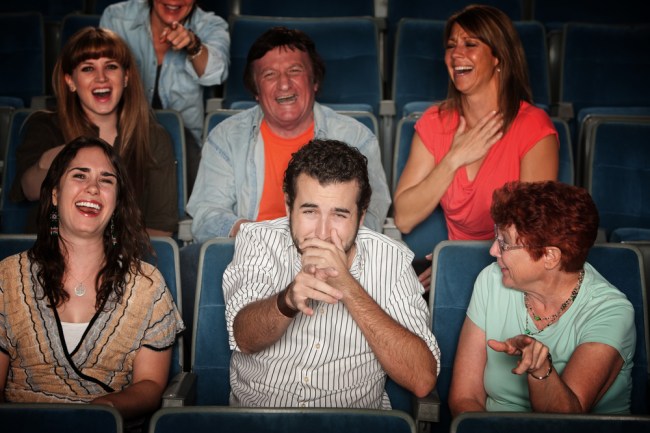
It’s been around for decades and has often been the butt of jokes, but the laugh track has a pretty interesting history behind it. It’s easy to write it off as a manipulative way to make us think TV shows are funnier than they really are, but the reasons it was created — and why it’s still used — are about more than just trying to fool people. Mother Nature News has a brief history of the laugh track and here are some highlights:
Laugh tracks were intended to make a pre-recorded production sound live.
Before broadcasting to an audience across an entire region and, later, nation, entertainment was generally delivered in a communal fashion: live performances in front of an audience. Hearing laughter and people reacting was par for the course. Since broadcasting was still in such early phases, many thought that not hearing an audience reacting would not be well-received because it wasn’t what people were used to. Jack Mullin, a pioneer in recording, says that the laugh track started with Bing Crosby’s radio show:
“The hillbilly comic Bob Burns was on the show one time, and threw a few of his then-extremely racy and off-color folksy farm stories into the show. We recorded it live, and they all got enormous laughs, which just went on and on, but we couldn’t use the jokes. Today those stories would seem tame by comparison, but things were different in radio then, so scriptwriter Bill Morrow asked us to save the laughs. A couple of weeks later he had a show that wasn’t very funny, and he insisted that we put in the salvaged laughs. Thus the laugh-track was born,” he told Channels of Communication, a trade journal, in 1981.
So live laughs were taking away from actual jokes from a genuinely funny broadcast. They were then edited separately and used for a less funny show. And that’s where the history of fooling us with peer pressure began.
Laugh tracks were needed for single-camera shows to make the audience sound consistent.
Today, a single-camera show refers to a show filmed without a studio audience that employs multiple angles with one camera. But when sitcoms began in the 1940s and 1950s, there was only one camera on the set. Several takes were needed to get a variety of angles, so the camera would stop rolling each time. But the audience would still laugh at the performance; that resulted in an inconsistent sound. Sound engineers used that as a great excuse to simply insert a solid laugh track when needed — and wanted; if a joke didn’t land as well as hoped, louder laughter was added as “sweetening.” Fun trivia to impress your friends: The first show to use a laugh track was The Hank McCune Show in 1950.
But around the ’60s, the laugh track started taking over the need for an audience completely and eventually replaced real people, saving costs on the production, but setting itself up — ironically — as a joke.
But despite their cheesy nature, laugh tracks actually improved shows for audiences.
Joke all you want, but a 1965 experiment proved that a show with a laugh track was interpreted as funnier than one without the added prompting. When Hogan’s Heroes premiered, the pilot was shown with a laugh track in some locations and without one in others. Ratings were higher in the locations who saw the version with the laugh track.
There was an actual “laff box.”
Much like Gene’s keyboard on Bob’s Burgers, a “laff box” machine was invented — and guarded very closely — by Charley Douglass, who developed an “encyclopedic knowledge” of the sounds he engineered into the device. The “organ-like” machine featured many different kinds of audience sounds based on gender, age, and the type of laugh and Douglass protected his invention so intensely that he held a monopoly on the laugh track in Hollywood. Over the course of three decades, Douglass carted the laff box around with him, occasionally re-recording the sounds to keep things current and fresh. You know, because those people laughing were probably dead.
There is a current version of the laff box that has been sized down and upgraded, according to Douglass’s son who continued in the family business.
When shows started producing their own sounds so they wouldn’t have to pay Douglass’s exorbitant fees, that was when the laugh track craze got out of hand and became a joke all by itself. By the end of the 1980s, some shows started to drop it and that paved the way for the single-camera shows that we recognize today, like Scrubs and Community.
But the laugh track still lives on, because as we’ve seen, some shows really need that little dose of “sweetening”:
Source: Mother Nature News






